Cycling and the ITB
 Introduction
Introduction
In this article I’m going to address the various type of problems cyclists report with their ITB including pain on the outside of the knee, pain at the hip, as well as general tightness and ‘twinges’ that the ITB is well known for. I’ll also include information on bike set up and stretches and strengthen exercises that can be done to prevent ITB problems.
What is the ITB?
ITB stands for ilio tibial band, it can also be known as the ilio tibial tract. It is not a muscle, it’s a band of strong connective tissue (fashia) that runs the entire length of the thigh, from the top of the hip to knee attaching at the outside of the lower knee, the knee joint capsule and the patella (kneecap). At the pelvis two muscles insert into it, the Tensor Fascia Latae (TFL) and the Gluteus Maximus.
The role of the ITB is to help stablise the pelvis, move the leg out to the side and internally rotate it, and assist with hip flexion. It performs these actions in conjunction with other muscles around the hip and pelvis, so a weakness or imbalance in these muscles can overload the ITB leading to pain and dysfunction.
For example, it works with the TFL and gluteus medius to adduct and internally rotate the leg. Studies have shown that weakness in the gluteus medius (often observed in cyclists) can also overload the TFL and hence ITB into which in inserts.
At the knee the ITB is thought to go over and back a bony prominence during knee flexion and extension. When the ITB is tight, additional friction over this prominence can lead to inflammation and pain. This is often termed the ITB friction syndrome or iliotiabial syndrome.

Signs & Symptoms associated with ITB dysfunction
Problems with the ITB can be felt from the knee right up to the lower back.
At the knee:
- Sharp or stabbing pain in the outside of the knee with possibly some decreased pedalling power due to pain, particularly at 30° of knee flexion. If severe, the pain can be experience off the bike when walking or going up or down stairs.
- Pain over the front of the knee or deep under the kneecap can be due to imbalances between the muscles on the outside of the knee, including the ITB, and the muscles on the inside. This imbalance pulls the kneecap towards the outside and prevents it tracking correctly over the knee leading to pain.
Along the ITB: Tightness or ‘twinges’ along the length of the ITB felt during activity.
At the hip: a tight upper ITB can be a factor in snapping hip syndrome. This is where flexion and extension of the hip produces a snapping sensation as the ITB moves over the head of the femur. It can cause local tenderness. There can be pain when lying on this hip at night. Other factor such as gluteal inflexibility or hip flexor tightness can also be contributors to this syndrome.
In the low back or pelvis: Due to its attachment at the hip, and association with other muscles in this area to maintain pelvic stability, a tight ITB can be a contributor to pain and decreased mobility in the low back or pelvis.
What’s causing the symptoms?
Cycling is very repetitive; during 1 hour of cycling, a rider may average up to 7,200 pedal revolutions. The smallest amount of misalignment, whether anatomic or equipment related, can lead to dysfunction, impaired performance, and pain.
Cause 1: Bike set up
- Saddle is too high: this results in knee extension greater than 150° which can irritate the ITB
- Saddle that is too far back causing excessive forward reach stretching the ITB
- Excess internal rotation (pointing in) of the tibia (lower leg) because of in correct cleat positioning which stresses the ITB
Cause 2: Anatomical reasons
- Leg length discrepancies: only one leg is correctly fitted to the pedal causing excessive stretching of the ITB on one side. Leg length discrepancies can occur due to rotations at the pelvis, or more unusually if you were born with them.
- A varus knee alignment (knees that lean inward), or excessive pronation at the feet (rolling in)
- Muscular imbalances around the hip and pelvis
Cause 3: Training
- Recent or quick changes in training/racing intensity or distance can be an aggravator of ITB pain.
Preventing or helping problems with ITB
The following is a list which should be considered as a means to prevent ITB problems, or to help resolve ITB pain if you are experiencing it.
Bike Set Up
First of all ensure that you bike is set up correctly so it’s not contributing to any of the ITB problems. The seat height may need to be lowered, or the seat brought forward a bit. Adjust the cleat so that they do not cause the lower leg to rotate inwards.
Training Schedule
Review your training or racing schedule, has there been a recent dramatic change in intensity or distance, could this be a contributor? Can you roll back a bit and introduce new changes in intensity or distance gradually?
Rest
No one likes to be told that they have to rest, but when movements like cycling aggravates the pain, then the aggravating action needs to be stopped to allow the inflammation to decrease and the area to heal. Rest alone is not enough for long term resolution, for this you need to determine and resolve the root cause of the problem.
Ice & anti-inflammatories
If the area is inflamed and sore, place some ice over the area for 10 minutes every hour. Wrap the ice in a cloth to prevent burns, and reapply when the heat has returned to the area. Speak to your pharmacist or doctor regarding anti-inflammatories as they can also help reduce the pain and inflammation.
Stretching & Strengthening
The ITB can be difficult to stretch. Two stretches are described below which should be introduced into your regular stretching routine. Foam rollers are a useful way to self massage the ITB and help loosen out tight or painful areas. Foam rollers are a cylinder of firm foam that you place under your ITB as you lie on your side. By moving the body up and down on the foam roller a self massage can be performed.
Stretch the muscles in the gluteal area. A tight Piriformis - a small muscle deep in the gluteal area which externally rotates the leg – can cause the gluteus medius to weaken and as a result overload the TFL & ITB. See the section on stretching for information on how to stretch the Piriformis.
A weak gluteus medius overloads the ITB. A rough guide to determine whether it is weak is to ask a friend to stay behind you and watch your hips as you cycle on the flat. Is there a lot of side to side hip movement? If so, this could be an indicator that the gluteus medius is weak (or that your saddle is too high!). Alternatively, with your fingers press the area just below the top of your pelvis at the back, move along from the centre towards the outside, are there tender spots?
Treatment
Get regular massages to work out tight muscles and prevent tightness turning into pain and time off the bike
Attend a Physical Therapist to get a full assessment of your pelvis, knee and ankle alignment and to determine the root cause of the ITB pain. They can work with you to correct any imbalances, do some deep tissue work into areas of dysfunction and give you a rehabilitation programme to get you back to pain free cycling.
Stretches & Strengthening Exercises
I have found that clients with ITB pain can often have tight piriformis as well as a weak gluteus medius. These are three exercises I suggest that they incorporate into their normal stretching & strengthening routine. All stretches should be performed when warmed up. Hold each stretch for 30 seconds and repeat three times daily. If you are stretching prior to racing or going training, hold the stretches for only 10 seconds.
Stretching
The ITB is difficult to stretch so I’ve also included a description on using a foam roller. The descriptions assume the right ITB is being stretched.
ITB Stretch 1:
- Stand with one foot in front of the other with a firm surface that you can use for support on your right e.g. table or chair
- Holding on to the support, bring the right leg behind the left, and bring it outside ways to the left.
- Bend your left knee and use your right arm for support as you bring your leg out to the side. Your right ankle /side of foot may be touching the floor
- Try to keep the trunk in an upright position.
- Repeat on the opposite side
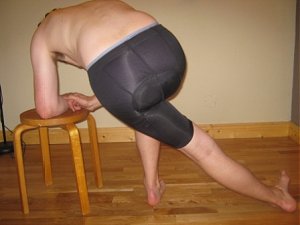
ITB Stretch 2:
- Lie on your left side with hips and knees flexed
- Draw the right leg behind and allow it drop towards the floor
- Use the other foot to apply some over pressure on the knee
- Repeat on the opposite side
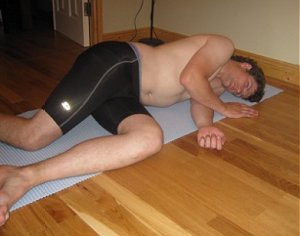
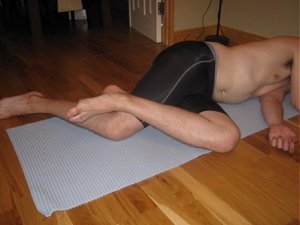
ITB Self Massage with Foam Roller
When using the foam roller, do so carefully. Do not be too vigorous as you may feel pain the next day.
- Lie on a firm surface with the side to be massaged down
- Place the roller under the ITB
- Move the body up and down on the roller to apply a self massage, alternatively, if there is one tender area apply pressure to this using the foam roller and wait until the tenderness eases (trigger point therapy)
Piriformis Stretch
You should feel this towards the side of the gluts near the head of the femur.
- Lie on your back
- Bend the right leg and draw the right knee on the side to be stretch towards the LEFT (i.e. opposite) shoulder
- Additional stretch can be added by holding the right ankle and pulling it gently towards your head.
- Repeat on the opposite side
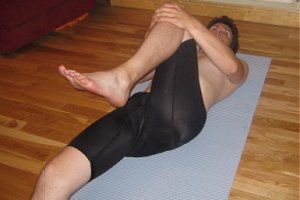
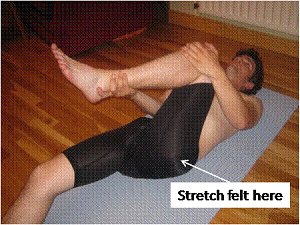
Strengthening Exercises
The keys to success with strengthening exercises are: 1) to do them slowly. If you do them fast then momentum starts to take over and the muscle is not working as much as it could; and 2) to return to the starting position slowly. This causes the muscle to contract eccentrically which is also a form of strengthening.
Gluteal Strengthening Exercise
In order to isolate the gluteus medius the position of the top leg is important. Try to keep it behind you as otherwise you start to recruit the TFL. Just raise the leg 2-3 inches above the hip. Any higher, you are recruiting additional muscles in the back to help lift the leg and not the gluteus medius
- Lie on your left side with your right side on top
- Bend the lower leg slightly at the hip and knee for stability
- Bring the right leg backwards slightly
- Slowly raise the upper leg until 2-3 inches over the hip
- From this position slowly lower and raise the leg (1 repetition)
- Perform three sets of 10-12 repetitions
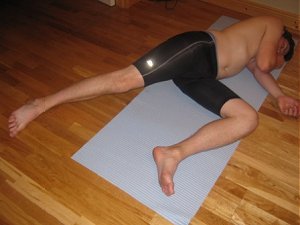
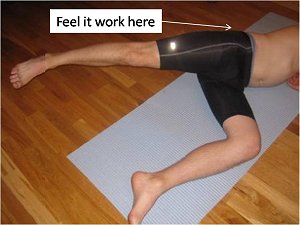
Place your hand on the gluts close to the hip bone. You should feel the contraction here as you raise your leg upwards. If you don’t move the leg backwards or forwards a little until you feel the contraction in this area.
Ankle weights can be added when the full three sets can be done as described above.
References
Brukner P, Kahn K 2007. Clinical Sports Medicine 3rd Edn. McGraw-Hill, North Rhyde
Hertling D, Kessler R 2006. Management of Common Musculoskeletal Disorders 4th edn. Lippincott Williams & Wilkins, Philadelphia
FaircloughJ, Hayashi K, Toumi H, Lyons K, Bydder G, Phillips N, Best T, Benjamin M 2006. The functional anatomy of the iliotibial band during flexion and extension of the knee: implications for understanding iliotibial band syndrome. Journal of Anatomy, 208 pp. 309-216
Fredericson M, Wolf C 2005. Iliotibial band syndrome in runners: innovations in treatment. Journal of Sports Medicine, 35 pp.451-9
Asplund C, St Pierre P 2004. Knee Pain and Bicycling. The Physician and Sports Medicine, 32
Fredericson M, Cookingham C, Chaudhari A, Dowdell B, Oestreicher N, Sahrmann S 2000. Hip Abductor Weakness in Distance Runners with Iliotibial Band Syndrome. Clinical Journal of Sport Medicine, 10 pp. 169-175
Kasunich N 2003. Changes in low back pain in a long distance runner after stretching the iliotibial band. Journal of Chiropracic Medicine, 2 pp.37-40